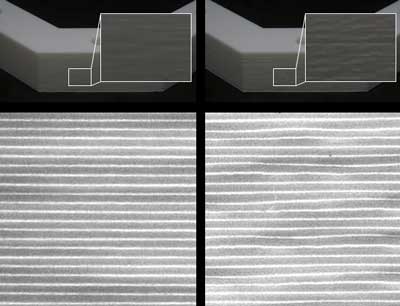| Jan 20, 2020 |
A technology for embedding data in 3D-printed objects
|
|
(Nanowerk News) A team from Nara Institute of Science and Technology (NAIST), composed of Ph.D. Student Arnaud Delmotte, Professor Yasuhiro Mukaigawa, Associate Professor Takuya Funatomi, Assistant Professor Hiroyuki Kubo, and Assistant Professor Kenichiro Tanaka, has developed a new method to embed information in a 3D printed object and retrieve it using a consumer document scanner.
|
|
Information such as a serial ID can be embedded without modifying the shape of the object, and be simply extracted from a single image of a commercially available document scanner.
|
 |
| 3D printed object (FDM) with embedded information. (Image: Optical Media Interface Lab, NAIST)
|
|
There are several technologies for 3D printing, but the most commonly used consists of deposing layers of molten plastic on top of each other. This method is known as Fused Deposition Modeling (FDM). Generally, plastic deposition is performed with layers of constant thickness. However, in the proposed method, pairs of vertically adjacent layers are selected, and their thickness balance is modified according to the information to be embedded. This thickness balance modification has little effect on the external shape of the object.
|
|
Additionally, the thickness of the printed layers can be measured precisely by scanning the object with a document scanner. The developed method allows to detect changes in layer thickness and extract the embedded information.
|
|
The results of this research were published in the international academic journal IEEE Transactions on Multimedia ("Blind Watermarking for 3D Printed Objects by Locally Modifying Layer Thickness").
|
Background and purpose
|
|
"Digital Watermarking" is a technology that embeds information inside digital contents such as image, audio, video, and 3D models. Some methods, such as barcode and QR code, embed information in a visible way. Other methods embed it covertly, with the additional information hidden in the content and not perceivable by the user.
|
|
Since 2010, the 3D printing technology has increasingly gained popularity, leading to a growing interest in the watermarking technology for 3D printed objects. In this research, we proposed a new method to embed a watermark during the printing of an object, and we focused on minimizing the distortion on the outer shape to prevent perturbation on the original function of the object.
|
 |
| Comparison of normal and new method. Left: normal print. Right: print with modified layer thickness using our method. Top: printed object. Bottom: scanned image with a document scanner. (Image: Optical Media Interface Lab, NAIST)
|
Characteristics
|
|
There are several technologies for 3D printing. Among them, Fused Deposition Modeling (FDM) is the most commonly used. It consists of deposing layers of molten plastic on top of each other. The desired shape is obtained by precisely controlling the position and flow of a printing nozzle such that the deposed plastic layers have a controlled path and thickness.
|
|
Generally, the plastic flow is controlled to produce a constant layer thickness. However, in our method, the plastic flow is modified during the print to locally change the layer thickness to embed some additional information. In order to prevent the degradation of the external surface of the object, pairs of vertically adjacent layers are selected and the ratio of their respective thicknesses is modified while keeping constant the sum of the two layer thicknesses.
|
|
Since a standard layer thickness is about 0.2mm, information can be embedded in a relatively small area ranging from several millimeters to a few centimeters.
|
|
To retrieve the embedded information, it is necessary to measure the thickness of the layers. However, our method can do this measurement using only a common document scanner, and does not require any special equipment. The FDM printing process naturally produce some layering artifacts that are visible in the images obtained by a document scanner. These artifacts allow us to measure the thickness of the layers and extract the information.
|
Future perspective
|
|
With this method, it is possible to embed various types of information such as an URL that can be linked to Web services, a unique ID that can be used for product tracing, and the printer ID and printing date for batch quality management.
|


